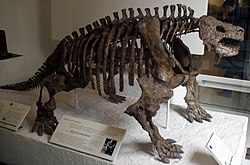Pareiasaur
| Pareiasaurs Temporal range: Middle Permian - Late Permian, 265–252 Ma |
|
|---|---|
 |
|
| Skeleton of Scutosaurus karpinskii in the American Museum of Natural History | |
| Scientific classification | |
| Kingdom: | Animalia |
| Phylum: | Chordata |
| Class: | Reptilia |
| Clade: | †Parareptilia |
| Order: | †Procolophonomorpha |
| Clade: | †Hallucicrania |
| Clade: | †Procolophonia |
| Clade: | †Pareiasauromorpha |
| Superfamily: | †Pareiasauroidea |
| Clade: |
†Pareiasauria Seeley, 1888 |
| Genera | |
|
|
Pareiasaurs (meaning "cheek lizards") are an extinct group of anapsid reptiles classified in the family Pareiasauridae. They were large herbivores that flourished during the Permian period.
Pareiasaurs ranged in size from 60 to 300 centimetres (2.0 to 9.8 ft) long, and may have weighed up to 600 kilograms (1,300 lb). They were stocky, with short tails, small heads, robust limbs, and broad feet. The cow-sized species Bunostegos, which lived 260 million years ago, is the earliest known example of a tetrapod with a fully erect posture as its legs were positioned directly under their bodies. Pareiasaurs were protected by bony scutes called osteoderms that were set into the skin. Their heavy skulls were ornamented with multiple knobs and ridges. The leaf-shaped multi-cusped teeth resemble those of iguanas, caseids, and other reptilian herbivores. This dentition, together with the deep body, which may have housed an extensive digestive tract, are evidence of a herbivorous diet. Most authors have assumed a terrestrial lifestyle for pareiasaurs, but bone microanatomy suggests a more aquatic, plausibly amphibious lifestyle.
Pareiasaurs appear very suddenly in the fossil record. It is clear that these animals are parareptiles. As such, they are closely related to Nycteroleterids. Like Rhipaeosaurs, they may have filled the large herbivore niche (or guild) that had been occupied early in the Permian period by the Caseid pelycosaurs and before then the Diadectid amphibians and Edaphosaur reptiles. They are much larger than the diadectids, more similar to the giant caseid pelycosaur Cotylorhynchus. Although the last Pareiasaurs were no larger than the first types (indeed, many of the last ones became smaller), there was a definite tendency towards increased armour as the group developed.
...
Wikipedia
